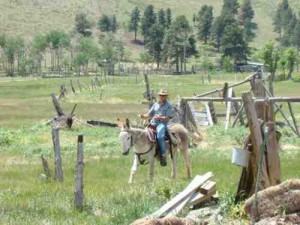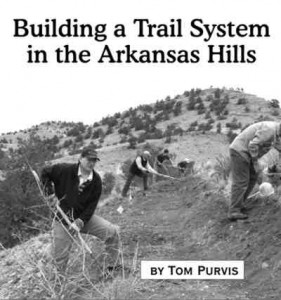Review by Ed Quillen
History – January 2009 – Colorado Central Magazine
A Tenderfoot in Colorado
by Richard Baxter Townshend
First published in 1923
Published in 2008 by University Press of Colorado
ISBN 978-0-87081-938-4
IN 1869, a young and educated Englishman stepped off the train in the wild frontier settlement of Cheyenne, Wyo., where he had several misadventures, and acquired a pistol and some knowledge of its use. Then he boarded a stagecoach for the struggling city of Denver, down in Colorado Territory.
After examining several opportunities, he set up as a ranchman on the Arkansas River side of the Black Forest Divide northeast of Colorado Springs before selling out and heading south to new frontier adventures in New Mexico Territory. Along the way, he encountered hostile Indians, sundry politicians, rustlers, wolves, and buffalo.
That’s the story in brief; the pleasure is in the telling, and Townshend provides an entertaining, often detailed, portrait of Colorado in its territorial days. Most of his Colorado career is spent along the Front Range, but he does venture into our part of the world, in the company of a traveling artist named Matthews who is supposedly working for Harper’s Weekly:
From Cañon City we plunged into the mountains, and a wonderful journey we had over the old toll-road; a rocky road it was and no mistake, but Matthews could drive and the mules were staunch and we did get up and down some awful hills. But to ease the work Matthews left his panorama in its huge coffin-like box at a little mountain town, and thus lightened we reached at last the summit of the Poncho Pass between the valley of the Arkansaw and the San Luis Park….
“I’ll tell you what we have found, though,” said Dick [Irwin, one of three prospectors they met near the summit], “and that’s the place where Frémont’s men eat each other.”
“Frémont!” sneered Matthews. “That’s the man they call ‘the Pathfinder,’ who was always lost.”
“Wal, he got lost that journey sure,” said Dick, “but I dunno as it was his fault. Ef he’s only ‘a’ had Kit Carson for a guide instead of Bill Williams it might have been all right. ‘Twas Bill Williams what lost ’em, and ’twas Bill Williams who started eating the dead ones when they got to starving.”
…”And you’ve seen the place?” I inquired.
“Yes,” he said. “It’s over west here and a bit north from the headwaters of the Del Norte. It’s pretty tough country to get through even in the summer, and what it might have been like in winter –” He broke off abruptly, leaving our imaginations to fill in the details.
…And so we parted from Dick, and drove on down into the glorious San Luis Park.
And a wonder it truly was with its ring of huge mountains round it as Governor Gilpin had said, and a precious long drive we had across it to Kerber Creek, where we camped, and from there on to Saguache, a tiny settlement of half a dozen houses, Mexican and American, just where the Saguache Creek emerged from the western mountains.
They go on to attend a treaty negotiation with the Utes at Los Piños, before returning to Denver where they part company. Like many English immigrants to early Colorado, Townshend wants to start a ranch where there’s plenty of open range, so he considers the Wet Mountain Valley:
A Prussian officer was said to have arranged to plant 300 German settlers in the Valley. His scheme was to plough up the rich bottom lands along the creeks which carried plenty of water to irrigate with, while the settlers’ cattle could roam at will over the free pasture in the rest of the Valley. This was enough to discourage any dreams I might have of starting a cattle ranch there; still, as I already had come so far to see the place, I decided to go in. I had rather a cold trip of it, for it was now December, and the mercury sometimes went down to zero, aye, and below, though so far there was little snow. But every creek formed ice along its banks, and winter was fairly on us. There were only as yet four settlers in the whole Valley when I reached it, and certainly the beauty of the Valley had not been exaggerated to me.
He found it full of game, but concluded that “the Wet Mountain Valley, beautiful as it was, did not offer the best prospects for a ranch, and somewhat regretfully I came away from it.”
Townshend then finds a partner, Lew Howell, to join him in a ranch, and with wagon and mules, they depart from Denver, crossing South Park en route to Saguache Creek, “which we hoped would prove our garden of Eden.” It offered “glorious bunch and buffalo grass everywhere, steep-sided cañons here and there for shelter, pine timber for fuel and for building, a splendid trout river for fishing, for watering stock, and for irrigation, and miles and miles of natural hay meadows. What could the heart of a cattleman want more?”
However, the Utes had other ideas, and so Howell and Townshend head for the Palmer Divide country, where they have further adventures in cattle-raising.
This book was fun to read, and I enjoyed its description of the Colorado of nearly 140 years ago at the time of the last free-running Indians and bison. Though Tenderfoot likely offers more than a few of what Mark Twain called “stretchers,” it seemed generally accurate. If you’re at all curious as to what Colorado was like before civilization started to dominate the place, you’ll enjoy these tales of A Tenderfoot in Colorado.


